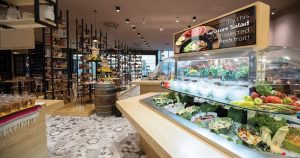— By Dan Smith —
Investing in the right commercial-grade digital signage is as strategic as a brand’s messaging.
Would you like fries with that? Increasingly, thanks to digital signage, the answer is yes. At quick-service, fast-casual and other national restaurants, digital signage and menu boards are gaining adoption and believed to contribute to increased sales. So it’s important that restaurants adopt technology that protects and augments those gains.

Dan Smith, LG Business Solutions USA
There’s plenty of opportunity out there. According to the QSR Drive-Thru Performance Study, about 20% of brands deployed digital menu boards.
The fact is, digital signage in QSRs and other restaurants can deliver real benefits. Digital signage makes it easy to comply with disclosure regulations, such as displaying calorie counts and allergens. Whether in a seating area or at a drive-thru lane, digital signage also enables automated scheduling of promotions and digital menu dayparts for breakfast, lunch and dinner. Scheduling simplifies operations and reduces labor costs by eliminating the need for employees to physically set up various menu boards throughout the day, while software solutions allow owners to make real-time changes, such as adjusting pricing, labeling an item as sold out or promoting limited-time offers.
 Adding digital signage is a wise, strategic investment that can directly impact QSR sales and revenue. By some estimates in Digital Signage Today, QSRs can recover their digital signage outlay in as little as 6 months, with 42% recouping their investment in one year or less. With the right technology, the return is even measurable, introducing the opportunity for fine tuning messaging or A/B campaign testing to further improve sales. With the right dynamic content, digital signage can help QSRs upsell customers on new, different, “missing” or value-added offerings.
Adding digital signage is a wise, strategic investment that can directly impact QSR sales and revenue. By some estimates in Digital Signage Today, QSRs can recover their digital signage outlay in as little as 6 months, with 42% recouping their investment in one year or less. With the right technology, the return is even measurable, introducing the opportunity for fine tuning messaging or A/B campaign testing to further improve sales. With the right dynamic content, digital signage can help QSRs upsell customers on new, different, “missing” or value-added offerings.
 Therefore, as digital signage becomes more of a brand standard to restaurants’ market position, it’s important that they implement technology that reliably supports their business goals. Some chains, franchises and local QSRs may be tempted to deploy a fleet of flat-screen consumer-grade TVs available from box stores — inexpensive and abundant. But such TVs, while well-suited for the home, were not built for the rigors of enterprise digital signage. They also lack features to help make the most of a digital signage network that spans many locations.
Therefore, as digital signage becomes more of a brand standard to restaurants’ market position, it’s important that they implement technology that reliably supports their business goals. Some chains, franchises and local QSRs may be tempted to deploy a fleet of flat-screen consumer-grade TVs available from box stores — inexpensive and abundant. But such TVs, while well-suited for the home, were not built for the rigors of enterprise digital signage. They also lack features to help make the most of a digital signage network that spans many locations.
Whether a restaurant brand is looking to get started with digital signage or expand and upgrade its existing signage network, there are many reasons it’s important to work with professional installers who specify commercial-grade displays:
- They’re built to last. Commercial digital signage displays last longer than consumer TVs. Designed to run up to 24 hours a day, 7 days a week, these displays have more robust protections that make them ideal for use in high-traffic environments. For example, a process called conformal coating used on LG’s QSR solutions protects the displays’ internal parts that would otherwise be susceptible to food, fine particles, dust, moisture and more.
- They’re brighter and more eye-catching. Commercial displays are generally brighter than consumer TVs (some twice as bright), because they have to be. QSRs and other restaurants are often well lit, meaning the digital signage needs to be brighter than a home TV set to achieve the same legibility and clarity. LG even offers truly ultra-bright (4000nits) displays so that customers can see images and text in direct sunlight — perfect for every type of drive-thru menu board. What’s more, brighter displays make food more captivating and show off the restaurant’s content better. Studies have shown that using videos and animations alongside digital images can boost food and beverage sales by more than 15%.
- They offer better value. Generally, consumer TV warranties last only one year and may even be voided if the TV is used in a commercial environment. Consumer TVs are not designed to operate 18 to 24 hours a day, unlike most commercial displays, many of which are capable of operating for 24 hours a day and are designed to work in harsh environments. When a bargain TV fails, the restaurant operator or franchisee usually needs to take it down and bring it in for service, leaving an ugly empty space that can remain unfixed for days. (Conversely, some commercial displays come with 24-hour “up-down” service through which the display provider ensures the troublesome display is fixed or replaced within 1 day.)
- They are more adaptable. From drive-thrus to self-service kiosks, orienting displays vertically in portrait mode empowers QSR owners to present content in ways that a horizontal display can’t match. This capability is nearly exclusive to commercial displays, as very few consumer TVs offer a portrait mode. Commercial displays also generally have more source input options than consumer models and are designed to integrate with remote monitoring, automation or content management systems.
- They’re simpler to operate. While most commercial digital signage displays are designed to run on computer networks, QSR screens are powerful enough all on their own. QSR displays include a built-in “system on a chip” that provides computer memory, a processor and webOS operating system. This enables the displays to play content without an external media player, which can reduce operating costs while simplifying installation and maintenance. With the ability to network displays together, operators can use a variety of software and services to monitor and even control virtually unlimited digital signage displays and menu boards across unlimited locations, from anywhere an internet connection is available.
For QSRs, fast-casual restaurants and others that operate multiple locations or support many franchisees, adopting commercial digital signage displays for all the above reasons can also ensure a common brand-appropriate customer experience across stores. A standard digital signage platform across multiple locations is not only easy to manage and service, it builds familiarity and trust between the brand and its guests. Finally, digital signage allows QSR brands to convey dynamic messaging for their customers regarding their brand values and the standards they support.
— Dan Smith is vice president, business, of LG Business Solutions USA.

